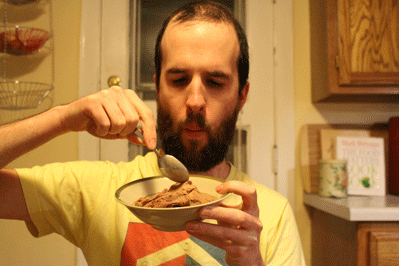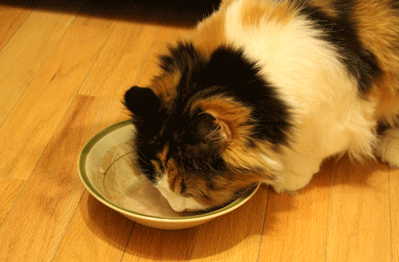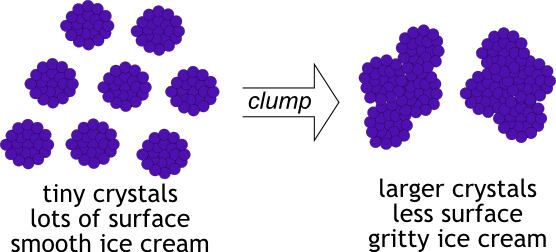…and what does that have to do with sustainable nanotechnology?
As with all good meals of information, let’s start this one off with ice cream!
In an effort to grow out of my “slim fit” clothes, I’ve begun an ice-cream-after-every-dinner diet.

Even the cat likes my diet!

An added bonus is that I go through jugs of ice cream so quickly that I NEVER have to deal with old, gross, crunchy ice cream! You know what I’m talking about. You reach into the back of your freezer, find that jug of 6-month-old ice cream, only to discover that it tastes like the perfect mixture of sugar, fat, and sand.
In order to understand this gritty phenomenon, let’s talk first about what gives freshly purchased ice cream that wonderfully non-gritty texture. The ice cream manufacturing process is controlled very carefully, such that the ice in ice cream comes in the form of lots of super-tiny ice crystals. These ice crystals are usually around 10 to 100 micrometers in size, which is so small that our tongues can’t even detect them as crystals, which is one reason ice cream is so smooth! However, if their size increases significantly, our tongue noticed the crystals and the ice cream tastes gritty.
But how do the crystals get bigger? Well, as we talked about in the previous post, small crystals have more surface area compared to an equal mass of large crystals. This means that lots of the atoms that make up small crystals are stuck out on the surface of those crystals, instead of being nestled on the inside. Those surface atoms would much rather be on the inside of the crystal, surrounded by other identical atoms. We scientists would say the surfaces of crystals have extra energy, relative to the insides of crystals.

As a consequence of this, small crystals are always looking for a way to grow larger so that a smaller percentage of their atoms will have to live on the crystal surface.
That is exactly what happens over time as ice cream sits in the freezer—the ice crystals find a way to grow larger—leading to that oh-so-disappointing gritty texture.
One way this crystal size growth can happen is when small crystals clump together to make larger crystals. This turns some of the unhappy surface atoms into happy interior atoms.

An even cooler way crystals can grow larger is by stealing individual unhappy surface atoms from other crystals. Basically, the surface atoms are so unhappy, they simply “abandon ship” and wash up on the shores of another crystal, making that second crystal larger. This process results in larger crystals growing and smaller crystals shrinking. This can continue to happen until the small crystals disappear completely! Cool!

What in the world does this have to do with nanotechnology? Well, if we shrunk the smooth-tasting ice crystals to be around 1,000 to 100,000 times smaller, they would be nano-ice crystals. We scientists would then call them “nanoparticles,” and we can make them from lots of different materials. Nanoparticles are so tiny that their surfaces have WAY MORE extra energy, and this energy can be harnessed to do some amazing things!
To choose one example of many—big chunks of gold can’t do much for a chemist except buy her lots of late-night meals and maybe a new car bike (we’re sustainable here, remember!). However, nano-sized chunks of gold have such energetic surfaces that they can link two different chemicals together—where nothing at all happens without the nano-gold.

The surfaces of nanoparticles can also be harnessed to degrade pollutants, turn fuels into electricity in fuel cells, and tons of other great stuff! Their surfaces are also largely responsible for how these materials behave in the environment and in organisms’ bodies (more on that soon!). So, the more we understand about these special surfaces, the better we can predict where nano-pollutants might end up and how toxic or non-toxic they might be. We can then hopefully use this information to design nanoparticles that are “benign by design.”
So, to stretch the ice cream analogy to its limits, it’s best to understand as much as we can about nanoparticle surfaces in order to avoid any gritty-tasting negatives, but there are still plenty of smooth-tasting positives!
References & Further Reading (subscription/purchase required for some):
Clark, C. The Science of Ice Cream; Royal Society of Chemistry: Cambridge, 2004.
Halford, B. Ice Cream. Chem. Eng. News, 2004, 82, 51.
Corma, A.; Garcia, H. Supported gold nanoparticles as catalysts for organic reactions. Chem. Soc. Rev., 2008, 37, 2096
An, K.; Somorjai, G. A. Size and Shape Control of Metal Nanoparticles for Reaction Selectivity in Catalysis. ChemCatChem, 2012, 4, 1512.
Zhong, C.J; Luo, J.; Fang, B.; Wanjala, B. N.; Njoki, P. N. Loukrakpam, R.; Yin, J. Nanostructured catalysts in fuel cells. Nanotechnology, 2010, 21, 1.
Mudunkotuwa, I. A. and Grassian, V. H. The Devil is in the Details (or the Surface): Impact of Surface Structure and Surface Energetics on Understanding the Behavior of Nanomaterials in the Environment. J. Environ. Monit. 2011, 13, 1135.

[…] mention of ice cream on this blog! Links: first, second, and […]
[…] one of the very first posts on this blog, Lee did a great job describing one of the most important properties of a great ice […]
Awesome Lee!!! This post about ice cream reminds me of Donna Blackmond’s work on deracemization and chiral resolution using recrystallization. Oswalt ripening may be detrimental to the taste of your ice cream, but it may also explain why we live in a homochiral world!!! http://pubs.acs.org/doi/abs/10.1021/ja303566g
Wowzillerz!!! I remember that paper. So crazy! Crystals have secret powers!!! 🙂
Nanoparticles in action… https://www.youtube.com/watch?feature=player_embedded&v=IPM8OR6W6WE#
A-MAZING! Thank you! So cool!! We’ll get u an explanation ASAP!
One way to stop the growth of tiny crystals into bigger ones (that our tastebuds dislike) is to use something that helps cover up crystals’ exposed surfaces. Several different arctic fish express “antifreeze” proteins that bind small ice crystals and keep them from forming large crystals that would cause damage to the animal’s cells. This happens because the protein-ice crystal interaction lowers the ice crystal surface energy and stabilizes the small ice crystals. You can use the same proteins to make ice cream that is always smooth!
http://www.nextnature.net/2012/09/antifreeze-protein-from-fish-blood-keeps-low-fat-ice-cream-rich-and-creamy/
Holy WOW that is amazing!!! Seems like biology has done it all! I’m not sure if people have used that same coating on nanoparticles, but they definitely use organic coatings to stop nanoparticles from sticking to stuff. Thanks for the comment & link!!!